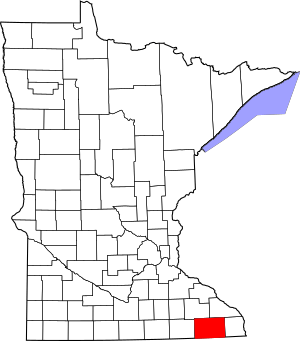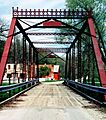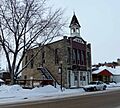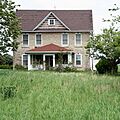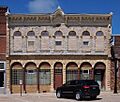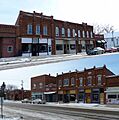National Register of Historic Places listings in Fillmore County, Minnesota facts for kids
This article is about the amazing historic places in Fillmore County, Minnesota that are listed on the National Register of Historic Places. Think of the National Register as a special list of buildings, sites, and objects across the United States that are important to our country's history. When a place is on this list, it means it's worth protecting and remembering for future generations. Fillmore County has 36 such special places!
Contents
History of Fillmore County's Historic Places
Fillmore County's historic places show us how this area grew, especially as a farming region in Southeast Minnesota. People from Europe started settling here in the 1850s. Back then, they used rivers and stagecoach roads to travel and move goods.
One cool example is the Forestville Townsite. It's now like a living museum where you can see what an early community was like. Several towns in the county wanted to be the main county seat. Buildings like the William Strong House in Carimona and the Fillmore County Jail and Carriage House in Preston are great examples from that time.
Fillmore County had many rivers and streams, which were perfect for powering mills. This area was very important for milling (turning grain into flour) before Minneapolis became the biggest milling city. Other places, like the Quickstad Farm Implement Company and Rushford Wagon and Carriage Company, show how important farming was to the county's manufacturing.
During a time of great wealth called the Gilded Age, towns like Spring Valley and Chatfield grew a lot. Many of their beautiful buildings from that time are now on the National Register because of their special architecture.
Historic Places You Can Explore
Here are some of the interesting historic places in Fillmore County:
Buildings and Homes
- Allis Barn (near Preston): This huge three-story barn was built around 1899. It's important because it shows how farming with livestock grew in the 1800s. It's also connected to the Allis-Chalmers company, which made farming equipment.
- Francis H. Bartlett House (Wykoff): Built in 1876, this house belonged to one of Wykoff's founders. It's a great example of Second Empire architecture, a fancy style popular back then.
- Chatfield Public Library (Chatfield): This library was built in 1915. It's a Carnegie library, meaning it was funded by Andrew Carnegie, and it's designed in the Prairie School architecture style.
- Commercial House Hotel (Spring Valley): This hotel, built in 1874, was very important for Spring Valley's growth, especially when railroads arrived and later cars became popular.
- Daniel Dayton House (near Harmony): Built in 1857, this is one of the few old stagecoach inns left in Minnesota. It was a stop on the stagecoach road between Dubuque and St. Paul. It's also known for its stone design.
- Samuel Thompson Dickson House (Chatfield): This 1863 house belonged to a rich mill owner. It's a key reminder of Chatfield's strong flour milling industry.
- Fillmore County Jail and Carriage House (Preston): This building, with its Italianate architecture style, was the county's jail and office from 1869-70. The carriage house was added around 1900. Today, it's a bed and breakfast!
- George H. Haven House (Chatfield): An Italianate architecture style house from 1874, with a Greek Revival architecture addition from 1892.
- Ellen M. Lovell House (Chatfield): Also known as Oakwenwald Terrace, this 1896 house is a top example of Shingle style architecture in Minnesota. It's now a bed and breakfast.
- Lenora Methodist Episcopal Church (near Canton): This church, built between 1856 and 1865, was a central part of one of Fillmore County's first settlements before railroads even reached the area.
- Norway Township Stone House (near Rushford): Built around the 1870s, this house is special because of its unique stone construction. It also shows the history of Norwegian immigrants settling in Fillmore County, especially in Norway Township.
- Parsons Block and Hall (Spring Valley): This fancy Italianate architecture building from 1871 had shops on the first floor and a meeting hall upstairs. It was a very important place for business and social gatherings in Spring Valley.
- Michael Scanlan House (Lanesboro): This Queen Anne style house from around 1892 belonged to a well-known person in Lanesboro who was active in business and local government. It's now a bed and breakfast.
- Spring Valley Carnegie Library (Spring Valley): Another Carnegie library, built in 1904. It's a great example of Beaux-Arts architecture and shows how Spring Valley was moving forward in the early 1900s.
- Spring Valley Mausoleum (Spring Valley): Built between 1913 and 1914 in the Spring Valley Cemetery, this mausoleum shows the growing wealth and modern ideas in Spring Valley during the Progressive Era.
- Spring Valley Methodist Episcopal Church (Spring Valley): This beautiful Victorian Gothic church was built between 1876 and 1878. It's famous for its colorful front and many stained glass windows. It's now the Spring Valley Methodist Church Museum.
- Ephraim Steffens House (Spring Valley): An 1877 Victorian Gothic house that belonged to a successful local businessman and politician.
- William Strong House (Spring Valley): This 1879 Second Empire architecture house belonged to a rich banker named William H. Strong.
- William Strong House (Carimona Township): This is William Strong's older house, built in the late 1850s. It's the only building left from an 1853 village that was important in Fillmore County's early days.
- Walker and Valentine House (Rushford): This house, built between 1859 and 1861, was for two of Rushford's founders. It's also known for being built with local stone.
Industrial and Commercial Sites
- Milwaukee Elevator (Preston): This grain elevator from 1902 is a great example of how these structures were built in rural Minnesota to store grain.
- Preston Brewery (Preston): Built in 1859, this is the oldest industrial building still standing in Fillmore County. It shows how Preston started as a settlement.
- Quickstad Farm Implement Company (Peterson): These buildings from 1875 and 1901 show the importance of making farming tools in the area. The newer building is also a good example of stone industrial buildings in Fillmore County.
- Rushford City Mill (Rushford): This 1875 mill shows Rushford's industrial growth and how important Fillmore County was as one of Minnesota's first places to produce wheat and flour.
- Rushford Wagon and Carriage Company (Rushford): This is the only building left from a factory that started in 1872. They made the famous Rushford Wagon, showing Rushford's role in making farm equipment.
- Southern Minnesota Depot (Rushford): This 1867 railway station shows how much the Southern Minnesota Railroad changed Rushford. The town grew rapidly when it became the end of the line for the railroad. It's now a museum and visitor center.
- Tunnel Mill (near Spring Valley): This gristmill from 1871 is unique because it was powered by water flowing through a tunnel that cut across a bend in a creek. It's the last mill left from a key milling area in Fillmore County. It's now a place for craft smithing.
Bridges and Rest Stops
- Bridge No. 5722 (Spring Valley): This bridge from 1936 is unusual because it's built on a concrete box culvert, which is not common for a U.S. highway bridge.
- Bridge No. L4770 (near Fountain): This short, curved stone arch bridge was built around 1915. It was a special type of bridge designed for rural southeast Minnesota. It might have been taken down since then.
- Inspiration Point Wayside Rest (near Lanesboro): This roadside park, built between 1934 and 1937, is one of Minnesota's first rest stops designed in the National Park Service rustic style. It's the only one left that was built by a Civilian Conservation Corps erosion control camp.
- Preston Overlook (Preston): An excellent example of an early Minnesota highway rest stop, built from 1937 to 1938. It's also known for its National Park Service rustic design by a famous landscape architect.
Historic Districts
- Forestville Townsite (Meighan Store) (Forestville Township): This 1853 townsite shows how quickly the frontier was settled after treaties in 1851. It's also linked to important political figures, William and Thomas Meighan. It's now a Minnesota Historical Society living history museum.
- Lanesboro Historic District (Lanesboro): This area has well-preserved commercial and industrial buildings from the 1800s. It shows what a milling and railroad town looked like back then, with 36 important properties.
- Wykoff Commercial Historic District (Wykoff): This district has many well-preserved buildings, mostly from the 1890s, that show what a busy farming center connected to the railway was like.
Images for kids


